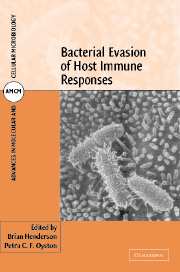Book contents
- Frontmatter
- Contents
- Contributors
- Preface
- Part I Recognition of bacteria
- 1 The dendritic cell in bacterial infection: Sentinel or Trojan horse?
- 2 CD1 and nonpeptide antigen recognition systems in microbial immunity
- 3 The NRAMP family: co-evolution of a host/pathogen defence system
- Part II Evasion of humoral immunity
- Part III Evasion of cellular immunity
- Index
- Plate section
- References
3 - The NRAMP family: co-evolution of a host/pathogen defence system
from Part I - Recognition of bacteria
Published online by Cambridge University Press: 13 August 2009
- Frontmatter
- Contents
- Contributors
- Preface
- Part I Recognition of bacteria
- 1 The dendritic cell in bacterial infection: Sentinel or Trojan horse?
- 2 CD1 and nonpeptide antigen recognition systems in microbial immunity
- 3 The NRAMP family: co-evolution of a host/pathogen defence system
- Part II Evasion of humoral immunity
- Part III Evasion of cellular immunity
- Index
- Plate section
- References
Summary
INTRODUCTION
Iron is essential for the growth of a wide range of microorganisms. Successful pathogens have developed several strategies to obtain host iron including use of siderophores to remove iron from transferrin, erythrocyte lysis and haemoglobin digestion, extracting iron at the cell surface, and procurement of host intracellular iron (Weinberg, 1999). Intracellular parasites such as mycobacteria have evolved complex mechanisms to acquire iron from their host cell, the macrophage (Wheeler and Ratledge, 1994). One such mechanism is a divalent cation transporter, known as Mramp (Agranoff et al., 1999). It is hypothesised that Mramp competes with its mammalian homologue Nramp1 for intraphagosomal iron and that this is important in determining the host's susceptibility to mycobacterial infection. This review will discuss the research that has led up to the elucidation of the Nramp1-Mramp story a fascinating example of the coevolution of prokaryotic/eukaryotic mutual evasion systems.
EARLY WORK ON Bcg
In 1981, Gros et al. recognised that among inbred strains of mice, innate susceptibility to infection with Mycobacterium bovis (BCG) was determined by a host genetic factor, which they named Bcg (Gros et al., 1981). Mice that possessed the dominant resistance gene, Bcgr, had 100- to 1000-fold fewer splenic colony forming units after intravenous injection of BCG-Montreal compared to the Bcgs susceptible strains (Forget et al., 1981).
- Type
- Chapter
- Information
- Bacterial Evasion of Host Immune Responses , pp. 39 - 52Publisher: Cambridge University PressPrint publication year: 2003
References
- 1
- Cited by

